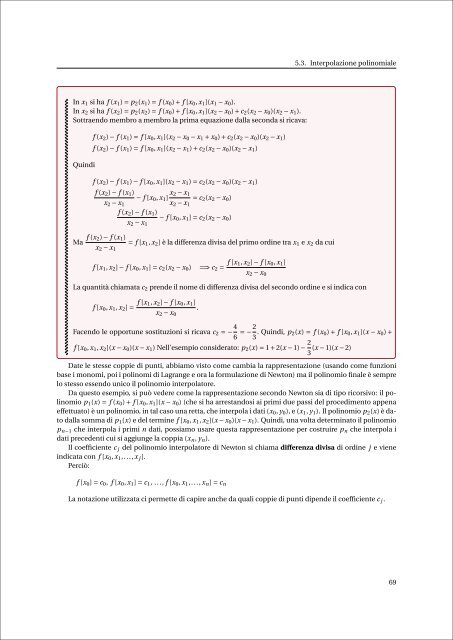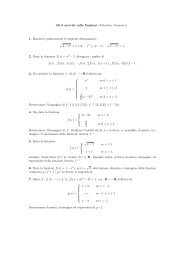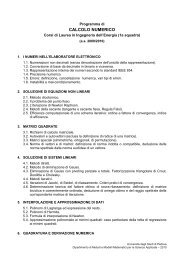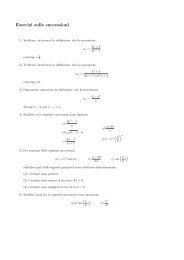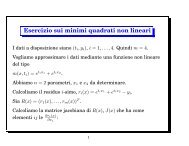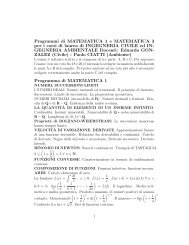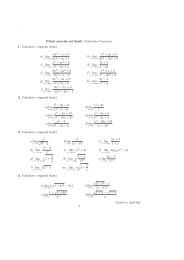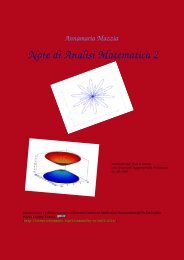Appunti di Calcolo Numerico - Esercizi e Dispense - Università degli ...
Appunti di Calcolo Numerico - Esercizi e Dispense - Università degli ...
Appunti di Calcolo Numerico - Esercizi e Dispense - Università degli ...
You also want an ePaper? Increase the reach of your titles
YUMPU automatically turns print PDFs into web optimized ePapers that Google loves.
5.3. Interpolazione polinomiale<br />
In x 1 si ha f (x 1 ) = p 2 (x 1 ) = f (x 0 ) + f [x 0 , x 1 ](x 1 − x 0 ).<br />
In x 2 si ha f (x 2 ) = p 2 (x 2 ) = f (x 0 ) + f [x 0 , x 1 ](x 2 − x 0 ) + c 2 (x 2 − x 0 )(x 2 − x 1 ).<br />
Sottraendo membro a membro la prima equazione dalla seconda si ricava:<br />
Quin<strong>di</strong><br />
f (x 2 ) − f (x 1 ) = f [x 0 , x 1 ](x 2 − x 0 − x 1 + x 0 ) + c 2 (x 2 − x 0 )(x 2 − x 1 )<br />
f (x 2 ) − f (x 1 ) = f [x 0 , x 1 ](x 2 − x 1 ) + c 2 (x 2 − x 0 )(x 2 − x 1 )<br />
f (x 2 ) − f (x 1 ) − f [x 0 , x 1 ](x 2 − x 1 ) = c 2 (x 2 − x 0 )(x 2 − x 1 )<br />
f (x 2 ) − f (x 1 )<br />
x 2 − x 1<br />
− f [x 0 , x 1 ] x 2 − x 1<br />
x 2 − x 1<br />
= c 2 (x 2 − x 0 )<br />
Ma f (x 2) − f (x 1 )<br />
x 2 − x 1<br />
f (x 2 ) − f (x 1 )<br />
x 2 − x 1<br />
− f [x 0 , x 1 ] = c 2 (x 2 − x 0 )<br />
= f [x 1 , x 2 ] è la <strong>di</strong>fferenza <strong>di</strong>visa del primo or<strong>di</strong>ne tra x 1 e x 2 da cui<br />
f [x 1 , x 2 ] − f [x 0 , x 1 ] = c 2 (x 2 − x 0 ) =⇒ c 2 = f [x 1, x 2 ] − f [x 0 , x 1 ]<br />
x 2 − x 0<br />
La quantità chiamata c 2 prende il nome <strong>di</strong> <strong>di</strong>fferenza <strong>di</strong>visa del secondo or<strong>di</strong>ne e si in<strong>di</strong>ca con<br />
f [x 0 , x 1 , x 2 ] = f [x 1, x 2 ] − f [x 0 , x 1 ]<br />
x 2 − x 0<br />
.<br />
Facendo le opportune sostituzioni si ricava c 2 = − 4 6 = − 2 3 . Quin<strong>di</strong>, p 2(x) = f (x 0 ) + f [x 0 , x 1 ](x − x 0 ) +<br />
f [x 0 , x 1 , x 2 ](x − x 0 )(x − x 1 ) Nell’esempio considerato: p 2 (x) = 1 + 2(x − 1) − 2 (x − 1)(x − 2)<br />
3<br />
Date le stesse coppie <strong>di</strong> punti, abbiamo visto come cambia la rappresentazione (usando come funzioni<br />
base i monomi, poi i polinomi <strong>di</strong> Lagrange e ora la formulazione <strong>di</strong> Newton) ma il polinomio finale è sempre<br />
lo stesso essendo unico il polinomio interpolatore.<br />
Da questo esempio, si può vedere come la rappresentazione secondo Newton sia <strong>di</strong> tipo ricorsivo: il polinomio<br />
p 1 (x) = f (x 0 ) + f [x 0 , x 1 ](x − x 0 ) (che si ha arrestandosi ai primi due passi del proce<strong>di</strong>mento appena<br />
effettuato) è un polinomio, in tal caso una retta, che interpola i dati (x 0 , y 0 ), e (x 1 , y 1 ). Il polinomio p 2 (x) è dato<br />
dalla somma <strong>di</strong> p 1 (x) e del termine f [x 0 , x 1 , x 2 ](x − x 0 )(x − x 1 ). Quin<strong>di</strong>, una volta determinato il polinomio<br />
p n−1 che interpola i primi n dati, possiamo usare questa rappresentazione per costruire p n che interpola i<br />
dati precedenti cui si aggiunge la coppia (x n , y n ).<br />
Il coefficiente c j del polinomio interpolatore <strong>di</strong> Newton si chiama <strong>di</strong>fferenza <strong>di</strong>visa <strong>di</strong> or<strong>di</strong>ne j e viene<br />
in<strong>di</strong>cata con f [x 0 , x 1 ,..., x j ].<br />
Perciò:<br />
f [x 0 ] = c 0 , f [x 0 , x 1 ] = c 1 , ..., f [x 0 , x 1 ,..., x n ] = c n<br />
La notazione utilizzata ci permette <strong>di</strong> capire anche da quali coppie <strong>di</strong> punti <strong>di</strong>pende il coefficiente c j .<br />
69


